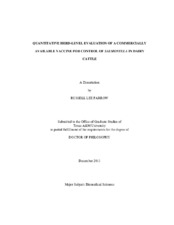| dc.description.abstract | Salmonella continues to threaten public health as well as negatively impact dairy producers on multiple levels. Efficacious solutions to control Salmonella among dairy cattle have long been sought to alleviate these problems. A novel vaccine technology has been developed based on purified siderophore receptors and porin proteins (SRP®) derived from Salmonella Newport. When vaccinated with these SRP® cattle are stimulated to produce antibodies which act in concert with host defenses to disrupt iron acquisition of pathogenic bacteria. To evaluate the effectiveness of this technology, a prospective cohort study was designed utilizing herds (n = 11) that practiced whole herd vaccination with the SRP® vaccine (vaccinated cohort) and herds (n = 11) that had not used the SRP® vaccine. Samples were collected during four rounds at approximately six week intervals from June through October 2009. Samples were transported to the laboratory at West Texas A&M University and cultured for the prevalence of Salmonella using selective enrichment methods. Salmonella isolates were evaluated for antimicrobial susceptibility and serotype. Data was analyzed using commercially available software to evaluate the herd-level effects of vaccination. Salmonella was ubiquitous throughout the Texas Panhandle and Eastern New Mexico, within-herd animal level estimates of prevalence ranged from 0.0 – 92%, over the length of the study period. Overall all rounds vaccinated herds had decreased (P = 0.012) Salmonella prevalence (15.3 vs. 27.5%). Vaccinated herds had numerically fewer Salmonella isolates belonging to the Newport serotype. Salmonella Typhimurium isolates were recovered approximately equally from vaccinated and non-vaccinated herds. Isolates from vaccinated herds were resistant to fewer antimicrobials throughout the study period. The ACSSuT(resistant to ampicillin, chloramphenicol, streptomycin, sulphisoxazole, and tetracycline) and MDR-AmpC (ACSSuT resistance plus resistance to ceftiofur and amoxicillin/clavulanate) resistant phenotypes were more frequently observed among non-vaccinated herds and none of the isolates from vaccinated or non-vaccinated herds were resistant to nalidixic acid, gentamicin, ciprofloxacin, or amikacin. These findings indicate vaccine efficacy for the reduction of Salmonella prevalence. Dairy operators along with herd veterinarians are encouraged to utilize this data with other herd specific factors in determining whether to use this specific vaccine. | en |


